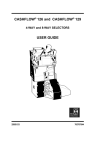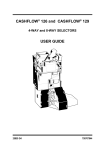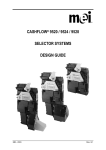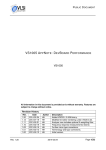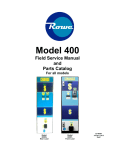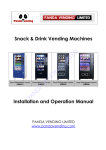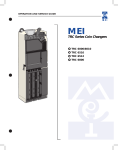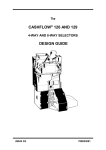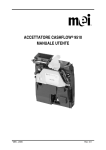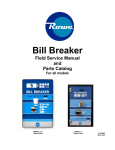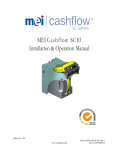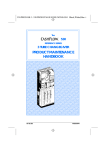Download CASHFLOW 130 ACCEPTOR USER GUIDE
Transcript
CashFlow® 130 Acceptor User Guide The ® CASHFLOW 130 ACCEPTOR USER GUIDE 27360 G1 ©, Mars, Inc., 1999 719521044 CashFlow® 130 Acceptor User Guide Published by: Mars Electronics International Eskdale Road Winnersh Triangle Wokingham, Berkshire, RG41 5AQ United Kingdom. Internet: http://www.meiglobal.com For further information on issues in other languages please write to the Technical Communications Manager at the above address. CashFlow® 130 Acceptor User Guide ©, Mars, Inc., 1999. All rights reserved Except as permitted under the relevant local legislation, no part of this publication may be copied, transmitted, transcribed, or distributed in any form or by any means, or stored in a database or retrieval system, or translated in any language (natural or computer), without the prior written permission of Mars Electronics International. Mars®, CashFlow® and the Mars Electronics International device are registered trademarks. ©, Mars, Inc., 1999. Mars Electronics International reserves the right to change the product or the product specifications at any time. While every effort has been made to ensure that the information in this publication is accurate, Mars Electronics International disclaims any liability for any direct or indirect losses (howsoever caused) arising out of use or reliance on this information. This document does not necessarily imply product availability. Part Number 719521044 This edition (May 1999) Printed in the United Kingdom. ii ©, Mars, Inc., 1999 CashFlow® 130 Acceptor User Guide CONTENTS Safety Summary 2 Product Identification 4 Electrical Interfaces 5 Installation 6 Product Features 8 Configuration 10 Maintenance 18 Product Support 19 ©, Mars, Inc., 1999 1 CashFlow® 130 Acceptor User Guide SAFETY Warning Before cleaning, servicing, removing or replacing CashFlow® units, ALWAYS SWITCH OFF or ISOLATE the ELECTRICITY SUPPLY to the machine. Caution This guide is for use only by personnel trained to carry out electrical installation. Dangerous Environments Do not operate the unit in the presence of flammable gasses or fumes, or after the entry of fluid into the machine. Disposal of Product If necessary, always dispose of defective units according to local regulations. Conformance to International Standards When installed and operated according to the instructions provided for the particular unit, CashFlow® products meet the applicable national and international safety standards for any country in which they are used. Safety All electrical connections to the product must be rated according to the requirements for “Accessible SELV” circuits as defined in EN60335-1. The product is therefore suitable for use in a class 2 (non-earthed or nongrounded) appliance. Over current protection is not included in the product and should be provided as part of the machine. The recommended fuse value at the rated supply of 12V is: 1A slow blow (to EN60127) Other protection methods may be used providing there over current characteristics remain within the overall operating characteristics of the above fuse. When used in applications where compliance to BS EN60950: 1992 is necessary, the host machine power supply must additionally meet the requirements for SELV limited power supplies as defined in BS EN60950 For these applications, the coin mechanism should be installed so that it is external to any fire enclosure. 2 ©, Mars, Inc., 1999 CashFlow® 130 Acceptor User Guide DOCUMENT GUIDE This document is for field engineers using the CashFlow® 130 product produced by Mars Electronics International (MEI). As an aid to using this document a series of symbols are used in the text and have the following meanings: F This indicates that a useful tip or word of advice is shown here. 0 Where this symbol is shown it indicates that a specific action is called for to ensure a successful installation or set-up of the product. v A note regarding the function to be carried out will appear beside this symbol. ©, Mars, Inc., 1999 3 CashFlow® 130 Acceptor User Guide PRODUCT IDENTIFICATION ® CashFlow 130 Side Entry CashFlow® 130 Top Entry 4 ©, Mars, Inc., 1999 CashFlow® 130 Acceptor User Guide ELECTRICAL INTERFACES Green Diagnostic LED Machine Interface Connector Machine Interface - This provides power to the validator and carries the coins inhibit signals from the machine and coin outputs to the machine. ©, Mars, Inc., 1999 5 CashFlow® 130 Acceptor User Guide INSTALLATION Installing or removing the CashFlow® product from your machine can be done by following these simple instructions. F When installing the CashFlow® 130-side entry product it will be fitted to an MEI Front Plate and the following instructions will always apply. ® F The mounting channel for the CashFlow 130 top entry product is supplied by the machine manufacturer, and therefore some variations may exist from machine to machine, however in principle these instructions still apply. CF 130 Front Entry Installation Bosses Retaining Clips 0 Having ensured that the front plate has a firm location onto the front of the machine, insert the side of the validator onto the two round bosses at the rear of the front plate and push firmly together until the two retaining clips are fully engaged. 0 Ensure the loom has not become disengaged or trapped during the installation. 6 ©, Mars, Inc., 1999 CashFlow® 130 Acceptor User Guide CF 130 Top Entry Installation Reject Lever Mounting Points Mounting Point F When mounted into a short channel the product must be fully assembled and ready for use, with only the machine interface loom to be connected. 0 The mounting points indicated must be firmly seated into the channel and a gap of between 2-3 mm left between the reject lever and the reject arm from the machine. This small gap will ensure that the validator lid is able to fully close when the reject button on the machine has been pressed and released. ©, Mars, Inc., 1999 7 CashFlow® 130 Acceptor User Guide PRODUCT FEATURES The CashFlow® 130 product has the flexibility to change certain settings such as varying the coin-set that it handles. These changes can be carried out using the rotary data switch and the configuration switch, which are fitted to the CashFlow® 130 product. The following pages show how, with the use of these switches, coins/tokens can be inhibited or enabled, either a new individual token or a group of tokens selected and the machine output mode changed. In addition to these two switches there is a green diagnostic LED which signifies if any changes you make have been successfully actioned or not. Green Diagnostic LED Rotary Data Switch Configuration Switches Coin/Token Acceptance When the product is successfully mounted you will need to confirm that it is set up correctly to accept good coins/tokens and direct them to where you want them to go. First things first 0 Press and release the reject button on the machine. Confirm that the lid on the front of the validator closes fully when the reject button is released. If it does not close fully the validator cannot function properly. 0 Test that power is on by checking that the green LED on the front of the validator is illuminated, it will flash off once when the reject lever is pressed. 8 ©, Mars, Inc., 1999 CashFlow® 130 Acceptor User Guide Testing for Acceptance 0 Insert into the machine a selection of all the coins/tokens shown on the validator label. The LED flashing off once will indicate acceptance of each one, and if the coin/token is outside of the programmed window it will flash off twice. If the LED flashes three times this indicates that the validator 4th sensor has rejected the coin/token. Should the LED flash off four times this indicates either a hardware or software inhibit is being applied. 0 If further help is required then consult the Operators Handbook for the product or contact either your distributor or local MEI office. COAS KIT The CashFlow® 130 may be fitted with a COAS kit (coin on a string). This is usually factory fitted and is only available on top entry products. The kit consists of a small circuit board and a paddle fitted to the entry components. When a coin is used with a string attached, the paddle is caught and the circuit detects the movement. This results in coins being inhibited. F- ALARM For German cigarette vending a link is set to allow an alarm output via the F inhibit line (host machine interface connector pin 4). This is active for approximately 500ms when an alarm condition is detected. For other applications the link is made so that the F inhibit line is an input from the host machine to allow a direct hardware inhibit. Note: when the F alarm link is made the all inhibit input from the host machine will continue to inhibit all coins, including the F coin. ©, Mars, Inc., 1999 9 CashFlow® 130 Acceptor User Guide CONFIGURATION Configuration Settings The 4 way teach switches can be set up as shown below to configure the product. Switch Switch Switch Switch 1 2 3 4 OFF ON X X X X X X X X X X X OFF OFF ON OFF ON ON ON ON OFF X X OFF ON OFF ON ON OFF OFF ON OFF X X ON OFF OFF ON OFF ON ON ON OFF Mode Selected Alarm Disabled Alarm Enabled Machine Interface Type Inhibit Coin/Token Teach Enable Coin/Token Teach Self Teach a Token to Channel 0 Self Teach a Token to Channel 1 Discriminator Node ID Select Fraud Defence Teach, Channel 0 Normal Operation Normal Operation Rotary Switch position/s required X X C-F C-F 0-F E-F E-F 0-6 E-F X X Diagnostic LED 0 The LED will illuminate to indicate that the product is powered up, and in addition will give various sequences of flashes to confirm the acceptance or rejection status of coins/tokens. F LED Flash Sequence: F Constantly ON Validator Power On. 1 Flash Coin accepted / Reject lever pressed. 2 Flashes Coin not recognised and rejected. 3 Flashes Coin rejected by validator 4th sensor. 4 Flashes Coin recognised but not accepted due to inhibit setting. 10 ©, Mars, Inc., 1999 CashFlow® 130 Acceptor User Guide Using the Rotary Data Switch and Configuration Switches Rotary Data Switch The rotary data switch is used in conjunction with the configuration switches. By pointing the arrow in the middle of the switch, using a fine screwdriver, data can be entered into the product. In Normal Operation mode, the position of the arrow is not critical to correct operation. Configuration Teach Switches These switches can be set to a series of positions, which enable the product configuration to be changed. When teach modes are to be entered first SWITCH POWER OFF to the unit, or Un-intended action could be set. The example given here, with both the rotary data switch and the configuration switch settings is to enable channel 3 in the coin set. F Wherever in the examples that follow the switch is shown as hatched Grey (usually switch 1) it indicates that it does not matter if the switch is in the ON or OFF position. Switch 1 only features in the settings for Alarm Enable when it must be in the ON position. When it is in the OFF position the Alarm function is NOT active. 0 After making any changes the configuration switches 2, 3, and 4 MUST always return to either of the Normal Operation positions shown here, before the changes are implemented. To Turn ON or Turn OFF the Alarm If switch one is set to OFF, the alarm feature will be disabled. If set to ON the alarm will be reactivated. Power to the validator can remain ON while the alarm feature is being set, thus the LED will continue to be lit at all times. ©, Mars, Inc., 1999 11 CashFlow® 130 Acceptor User Guide Product Configuration - Inhibiting coins or tokens Example:- To inhibit channel 2 (the 5p coin) on your validator follow these simple steps. Channel Inhibit ON 1 2 3 Set switches 2, 3 and 4 as shown here. 4 1. Switch Validator Power OFF. ON 1 Set 4 Way Switches to Inhibit Teach. 2 2. 3 4 3 4 5 6 B C D F 0 1 2 3. E Set Rotary Switch Dial to the appropriate channel. (Channel No. 2 for the 5p in this instance). 7 8 9 A 5. Set switches 2, 3 & 4 to ON. (LED will stop flashing and stay on). The Rotary Switch settings can be left unchanged. 2 3 4 6. 12 ON Switch Validator Power ON (LED will flash). 1 4. The chosen coin is now inhibited and the product is END ready for normal operation. For each additional channel to be inhibited repeat process from 1 above. ©, Mars, Inc., 1999 CashFlow® 130 Acceptor User Guide Product Configuration Enabling Coins or Tokens Example: - To enable channel 2 (the 5p coin in this instance) on your validator follow these simple steps. Channel Enable ON 1 2 3 Set switches 2, 3 and 4 as shown here. 4 1. Switch Validator Power OFF. ON 1 Set 4 Way switches to Enable Teach. 2 3 2. 4 3 4 5 6 B C D F 0 1 2 3. E 7 8 9 A 4. Switch Validator Power ON (LED will flash). 2 3 4 6. ON 1 5. Set Rotary Switch Dial to the appropriate channel. (Channel No. 2 for the 5p in this instance). Set switches 2, 3 & 4 to ON. (LED will stop flashing and stay on). The Rotary Switch settings can be left unchanged. The chosen coin is now enabled and the product is END ready for normal operation. For each additional channel to be enabled repeat process from 1 above. ©, Mars, Inc., 1999 13 CashFlow® 130 Acceptor User Guide Product Configuration – Self teaching a new token, channel 0 Example: - To Teach a Token (with standard window limits) into channel 0 follow these simple steps. LED Flash Codes for Tokens: Channel Enable 2 flashes = No activity detected (for last 30 seconds) ON 1 3 flashes = Insufficient Tokens (10 min.) 2 3 Set switches 2, 3 and 4 as shown here. 5 flashes = Token thickness outside allowable limits 4 6 flashes = Token diameter outside allowable limits 7 or 8 flashes = Token material outside allowable limits 1. Switch Validator Power OFF. on 1 Set 4 Way switches to Token Teach. 2 2. 3 4 F 0 1 3 4 5 6 B C D E 2 3 Set Rotary Switch Dial to position F (standard window limits) (Position E will teach narrow token window limits). 7 8 9 A 5. Drop between 10 and 20 Tokens. 6. Return switches to Normal Operation. (LED should stop flashing and stays on to indicate a successful change). If the LED continues to flash this indicates failure to teach the token. If needed repeat the process from step 1. ON Switch Validator Power ON (LED will Flash). 1 4. 2 3 4 7. END 14 Token successfully taught & programmed into Channel 0. ©, Mars, Inc., 1999 CashFlow® 130 Acceptor User Guide Product Configuration – teaching a new token, channel 1 Example: - To Teach a Token (with standard window limits) into channel 1 follow these simple steps. LED Flash Codes for Tokens: Channel Enable 2 flashes = No activity detected (for last 30 seconds) ON 1 3 flashes = Insufficient Tokens (10 min.) 2 3 Set switches 2, 3 and 4 as shown here. 5 flashes = Token thickness outside allowable limits 4 6 flashes = Token diameter outside allowable limits 7 or 8 flashes = Token material outside allowable limits 1. Switch Validator Power OFF. ON 1 Set 4 Way switches to Token Teach. 2 3 2. 4 B C D 3 4 5 6 3. F 0 1 2 E Set Rotary Switch Dial to position F (standard window limits). (Position E will teach narrow token windows). 7 8 9 A 5. Drop between 10 and 20 Tokens. 6. Return switches to Normal Operation. (LED should stop flashing and stays on to indicate a successful change). If the LED continues to flash this indicates a failure to teach the token. If needed repeat the process from step 1. ON Switch Validator Power ON (LED will Flash). 1 4. 2 3 4 7. END Token successfully taught & programmed into Channel 1. ©, Mars, Inc., 1999 15 CashFlow® 130 Acceptor User Guide Product Configuration – Changing the machine output mode To change the coin output interface to Fixed Binary Coded Output (BCO) use these simple steps. For BCO mode set the rotary data switch to position C, to D for Fixed Parallel mode and F for Automatic mode. v NOTE: The product will normally be supplied in Parallel mode. Example:- To set mode to Binary Coded Output 1. Switch Validator Power OFF. ON 1 Set 4 Way switches to Output Mode Teach. 2 3 2. 4 3 4 5 6 B C D F 0 1 2 3. E Set Rotary Switch Dial to appropriate position. (In this example Position C). 7 8 9 A 5. Set switches 2, 3 & 4 to ON. (LED will stop flashing and stay on). Leave the Rotary Switch settings as they are. ON Switch Validator Power ON (LED will Flash). 1 4. 2 3 4 6. 16 END Product is now ready for use with the chosen machine interface. ©, Mars, Inc., 1999 CashFlow® 130 Acceptor User Guide Product Configuration - Fraud Defence Teach This feature allows a fraudulent coin to be taught to channel 0 of the validator so that it can recognise it as a slug and can then reject it. F 0 1 2 3 3 4 5 6 2 Set switches 2, 3 and 4 as shown here. E B C D ON 1 Enable Fraud Defence 7 8 9 A 4 This feature requires 3 steps: v 1. Teach the fraudulent coin/token as you would a token into channel 0, as shown on page 13. v 2. Set 4 way teach switches as shown in the example below to identify the channel as a slug. v 3. Enable channel 0, as shown on page 12. 1. Switch validator power OFF. ON 1 2 Set 4 way teach switches to enable fraud defense. 3 2. 4 Set rotary data switch to position E. ON 7 8 9 A 1 2 4. 3 4 5 6 B C D F 0 1 2 3. E Switch Validator power ON (LED will flash). 3 4 5. LED stops flashing and stays on to indicate successful change. 6. END Fraud successfully taught into channel 0. The Validator will now reject taught fraud coin the next time it is seen. ©, Mars, Inc., 1999 17 CashFlow® 130 Acceptor User Guide MAINTENANCE F The practical maintenance that can be carried out is limited to cleaning the areas of the Validator that the coins travel through, and the replacement of the coin entry liner if it becomes worn. All other servicing is carried out through your distributor. The cleaning should be carried out on a regular basis of at least once a month, but, if you have to visit the validator outside of that routine, it is worth while doing it then as well. The shaded areas shown below, plus the back of the reject cover, are those to be cared for. Unscrewing the coin entry moulding at the top of the validator accesses the coin entry liner. The coin entry liner can then be eased off with the aid of a fine screwdriver, and a replacement slid into place. 0 Suitably trained personnel must only carry out cleaning and maintenance. 0 Cleaning must only be carried out after power has been removed from the product. 0 Never use a cleaner containing solvents, scrapers or abrasive materials. 0 Never apply water or cleansers directly onto the product. Always apply them to a clean cloth first, and not too liberally, so that the cloth used is only moist. Coin Entry Liner Coin Entry Moulding Screw Areas to Clean 18 ©, Mars, Inc., 1999 CashFlow® 130 Acceptor User Guide PRODUCT SUPPORT In addition to the MEI offices around the world, an international network of Distributors and Approved Service Centres can offer you technical support and other services as well. These services include repairs, re-programming of your CashFlow® products with new coinsets, replacing damaged modules, and the supply of a range of spare parts. GREAT BRITAIN MARS ELECTRONICS INTERNATIONAL ESKDALE ROAD WINNERSH TRIANGLE WOKINGHAM BERKSHIRE, RG41 5AQ TELEPHONE: 0118 - 9697700 FACSIMILE: 0118 - 944612 MARS UNITED STATES MARS ELECTRONICS INTERNATIONAL 1301 WILSON DRIVE WEST CHESTER PA 19380 TELEPHONE: 610 - 4302500 FACSIMILE: 610 - 4302694 AUSTRALIA MARS ELECTRONICS INTERNATIONAL 302 PARRAMATTA ROAD AUBURN NEW SOUTH WALES, 2144 TELEPHONE: 2 - 97375390 FACSIMILE: 2 - 97375399 CANADA MARS ELECTRONICS INTERNATIONAL 37, HOLLAND DRIVE BOLTON ONTARIO, L7E 5S4 TELEPHONE: 416 - 239 - 2782 FACSIMILE: 416 - 239 - 3322 FRANCE MARS ELECTRONICS INTERNATIONAL BOULEVARD DES CHENATS - BP 7 45550 ST. DENIS DE L'HOTEL TELEPHONE: 2 - 38 - 59 - 6534 FACSIMILE: 2 - 38 - 59 - 6838 GERMANY MARS ELECTRONICS INTERNATIONAL INDUSTRIERING 17 A 41751 VIERSEN TELEPHONE: 02162 - 9560 FACSIMILE: 02162 - ITALY MARS ELECTRONICS INTERNATIONAL 27011 BELGIOIOSO (PV) VIALE DANTE, 40 TELEPHONE: 0382 - 979313 FACSIMILE: 0382 - 970790 JAPAN MARS ELECTRONICS INTERNATIONAL A DIVISION OF MASTER FOODS LTD. 3F MUSASHI-KOSUGI TOWER PLACE 403 KOSUGIMACHI 1-CHOME NAKAHARA-KU, KAWASAKI-SHI KANAGAWA-KEN 211 TELEPHONE: 44 - 712 - 1315 FACSIMILE: 44 - 712 - 1439 SPAIN MARS ELECTRONICS INTERNATIONAL M.a DE MOLINA, 40-3a 28006 MADRID TELEPHONE: 1 - 590 - 8782 FACSIMILE: 1- 590 - 8755 SWITZERLAND MARS ELECTRONICS INTERNATIONAL CH. PONT-DU-CENTENAIRE 109 PLAN-LES-OUATES P.O. BOX 2650 1211 GENEVA 2 TELEPHONE: 22 - 8840505 FACSIMILE: 22 - 8840504 ©, Mars, Inc., 1999 19 Helping you deliver Representetive






















